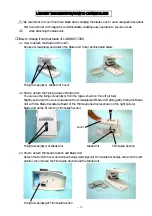
AMBE-2000™ Vocoder Chip Users Manual
Version 4.92, June, 08
DVSI Confidential Proprietary, Subject to Change
Page 60
Visit us at
www.dvsinc.com
8.6
Soft Decision Decoding
In modern communication systems the transmitter transmits information in the form of symbols. The demodulator takes the
received signal and tries to decide which symbol was transmitted. In other words, the demodulator is making a decision
based on the received signal. For instance, in a binary system, the symbols could be represented by a 1 and a 0. Because of
interference and many other factors, these signals can be misinterpreted because of channel degradation. Significant
improvement in FEC performance can be added by setting up the receiver so that the demodulator is making a finer
estimation of the received energy prior to the decoder, this is called soft-decision decoding. The link below describes this in
more detail.
http://www.mathworks.com/access/helpdesk/help/toolbox/commblks/usersguide/tutor135.shtml
The AMBE-2000/2020 utilizes a 4 bit soft decision decoder. The bits are defined as follows:
Decision Value
(Binary)
Interpretation
0000
Most confident
0
0111
Least confident
0
1000
Least confident
1
1111
Most confident
1
Placing a logic high on pin 79 of either the AMBE-2000™ or AMBE-2020™ vocoder chips enables the soft decision error
correction on the decoder. Enabling the soft-decision does nothing to the encoder packet. The packet will look like a normal
encoded packet. The user must implement circuitry at the receive end of the channel for making a finer (4 bit) estimation of
the received energy (see above link for an explanation of how this can be done).
The AMBE-2000/2020 decoder packet structure is altered. The decoder expects each voice data bit of the encoded packet to
be represented by 4 soft decision (SD) bits. The decoder will make the decision of whether or not a 1 or a 0 is represented by
the SD bits. Table 1 is an example of a soft-decision decoder packet.






































